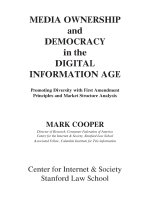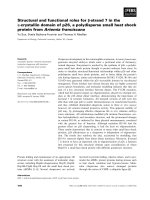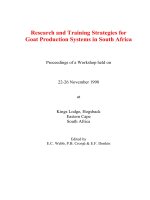Entry strategies for de alio firms in the digital music player industry
Bạn đang xem bản rút gọn của tài liệu. Xem và tải ngay bản đầy đủ của tài liệu tại đây (908.44 KB, 112 trang )
ENTRY STRATEGIES FOR DE-ALIO FIRMS
IN THE DIGITAL MUSIC PLAYER INDUSTRY
LI WEN
NATIONAL UNIVERSITY OF SINGAPORE
2010
ENTRY STRATEGIES FOR DE-ALIO FIRMS
IN THE DIGITAL MUSIC PLAYER INDUSTRY
LI WEN
A THESIS SUBMITTED
FOR THE DEGREE OF MASTER OF ENGINEERING
MANAGEMENT OF TECHNOLOGY
DIVISION OF ENGINEERING AND TECHNOLOGY MANAGEMENT
FACULTY OF ENGINEERING
NATIONAL UNIVERSITY OF SINGAPORE
2010
ACKNOWLEDGEMENTS
I would like to acknowledge and extend my heartfelt gratitude to the following persons
who have rendered me unstinting help during this project.
I am deeply grateful to my supervisor, Prof Hang Chang Chieh, for his constant guidance
and support. Prof. Hang not only guided my research academically, he is also my advisor
in life. He has been a wonderful supervisor, responsible and energetic. I enjoyed and
would like to thank him every moment I spent with him.
I am fortunate to have Dr. Annapoornima M. Subramanian as my co-supervisor. I
appreciate every effort she has made to shape my critical thinking, my logic and my
attitude to research. She is not only my mentor, but friend. I would not have completed
this thesis timely without her continuous guidance and assistances.
I would like to thank other professors and colleagues in Division of ETM, ISE
Department, for their kind support and help during my study. They are Dr. Chai Kah Hin,
Prof. Tham Ming Po, Associate Prof. Ang Marcelo Jr Huibonhoa, Dr. Yu Dan, Zhao
Yangyang, Sathish Kumar, Cheng Yu Chao.
I was very fortunate to have the opportunity to discuss research questions with visiting
academics, Prof. Wim Vanhaverbeke. I would like to thank him for his time and support.
I also want to express my sincere gratitude to my family. I would like to thank my
grandparents, who brought me up until primary school. I would like to express my
deepest thanks and extreme regret to my grandfather, who passed away years ago. I wish
to thank my parents, Li Dongxue and Xu Shufang, for their kindest understanding,
ii
support and encouragement. Last but not least, I‟d like to thank my twin sister, Li
Zhuoting, for every moment we have shared with each other, especially when
encountering obstacles we have tackled together.
Without them, the completion of this thesis would not have been possible.
Li Wen
Nov 2010
iii
TABLE OF CONTENTS
ACKNOWLEDGEMENTS ................................................................................................ ii
TABLE OF CONTENTS ................................................................................................... iv
SUMMARY ..................................................................................................................... viii
LIST OF TABLES .............................................................................................................. x
LIST OF FIGURES ........................................................................................................... xi
1.
2.
3.
Introduction ................................................................................................................. 1
1.1
Motivation ............................................................................................................ 1
1.2
Research Objectives ............................................................................................. 2
1.3
Thesis Structure .................................................................................................... 3
Literature Review........................................................................................................ 7
2.1
Introduction .......................................................................................................... 7
2.2
The Dynamics of Entry Strategy .......................................................................... 7
2.3
Complementary Asset Perspective ....................................................................... 8
2.4
Research Questions ............................................................................................ 14
Research Methodologies ........................................................................................... 16
3.1
Introduction ........................................................................................................ 16
3.2
Classification of Research Methodologies ......................................................... 16
iv
3.2.1
Rationalism versus Interpretivism .............................................................. 16
3.2.2
Single-case versus Multiple-case Study...................................................... 19
3.3
Reasons of using Single-Case Study .................................................................. 19
3.4
Case Study Protocol of Digital Audio Player Industry ...................................... 21
3.4.1
Selection of Suitable Case .......................................................................... 21
3.4.2
Data Collection Methods ............................................................................ 22
3.5
4.
5
Conclusion.......................................................................................................... 24
Research Context ...................................................................................................... 25
4.1
Introduction ........................................................................................................ 25
4.2
Focus Industry .................................................................................................... 25
4.2.1
The Pre-Mp3 Story: Philips and Sony ........................................................ 26
4.2.2
MP3 History ................................................................................................ 28
4.3
Focus Firm.......................................................................................................... 33
4.4
Conclusion.......................................................................................................... 38
Analysis and Discussion ........................................................................................... 39
5.1
Introduction ........................................................................................................ 39
5.2
Firm entry behavior analysis & Patent stock analysis........................................ 39
5.2.1
Early flash drive based player ..................................................................... 40
5.2.2
Digital Audio Player Information in the later stage .................................... 45
v
5.2.3
Patent Analysis............................................................................................ 52
5.2.4
Conclusion of Firm Entry Strategies........................................................... 56
5.3
5.3.1
Music Management Software ..................................................................... 59
5.3.2
Music Content Distribution: Online Music Files and Online Music Store . 65
5.3.3
Storage Media: Flash-based or Hard drive-based ....................................... 72
5.3.4
Data Transfer/ Connection .......................................................................... 74
5.4
6
Complementary Assets Analysis ........................................................................ 57
Firm Entry Strategy ............................................................................................ 76
5.4.1
Creative Technology ................................................................................... 76
5.4.2
Apple ........................................................................................................... 78
5.4.3
SanDisk ....................................................................................................... 81
5.4.4
Microsoft ..................................................................................................... 82
5.5
Research Discussion ........................................................................................... 84
5.6
Conclusion.......................................................................................................... 86
Findings and Conclusion........................................................................................... 87
6.1
Introduction ........................................................................................................ 87
6.2
Research Findings .............................................................................................. 87
6.3
Contribution to the Literature ............................................................................. 88
6.4
Implications for Open Innovation ...................................................................... 90
vi
6.5
Implication for Exploitation and Knowledge Flow............................................ 91
6.6
Implication for Collaboration ............................................................................. 92
6.7
Limitations ......................................................................................................... 93
6.8
Overall Conclusion ............................................................................................. 94
References ......................................................................................................................... 95
vii
SUMMARY
Academics have discussed the dynamics between new entrants and incumbents and the
complementary assets needed to commercialize a technology. This thesis discusses the
special situation of de-alio entrants, built on the synthetic framework proposed by GansStern (2003) and He et al. (2006). As presented by Gans-Stern (2003), when intellectual
property protection is poor and incumbents have control over the necessary
complementary asset, which are assets, infrastructure or capabilities needed to support
the successful commercialization and marketing of a technological innovation, the new
entrants are in a very venerable position. . The assumption of Gan-Stern‟s framework is
that the entrants are de-novo entrants/ entrants without pre-experience. He et al. (2006)
made a significant contribution to this stream of literature by highlighting the existence
and a special situation of de-alio entrants. Equipped with previous industry experience,
de-alio entrants can adopt different entry strategies, leveraging on complementary assets
first, and building up intellectual property later. However, we question whether this is the
only possible entry strategy for de-alio entrants.
Based on the literature review, we raised the following research questions:
Whether there exist different entry strategies for de-alio entrants?
What are the possible factors that trigger the different entry strategies adopted by
different de-alio entrants?
To address the above research question, we have investigated the digital audio player
industry, adopting the complementary assets perspective. The digital audio industry
presents an interesting case of entry behaviors consistent with the approach described
viii
above. Both the intellectual property and complementary assets are important for digital
audio player industry. Through secondary data analysis, including archival records,
documentation and physical artifacts, and patent data analysis, we illustrated how several
digital audio player firms pursued different entry strategies: leveraging on existing
complementary assets first, followed by building up intellectual property or vice-versa;
we then discussed what factors that determine which strategy they choose. We present the
following conclusions to provide suggestions to academic researchers and industry
managers in the area of entry strategy management of de-alio firms.
There exist two possible entry behaviors: leveraging on existing complementary
assets first followed by building up intellectual property or vice-versa. Our study
confirmed the presence of de-alio entrant in a new context.
The different entry paths followed by de-alio are contingent on the kind of
complementary assets they hold: specialized or generic. Specialized assets could
serve as a source of competitive advantage and allow de-alio entrants to establish
a foothold on market first. Generic complementary assets could not provide
significant competitive advantage of de-alio entrants to leverage, compared with
de-novo entrants. Hence, it is reasonable for them to adopt similar strategy as denovo entrants to invest on intellectual property.
ix
LIST OF TABLES
Table 3.1: Advantages and Disadvantages of rationalist and case research methods ...... 18
Table 3.2 Data Source ....................................................................................................... 24
Table 4.1 History of MP3 ................................................................................................. 31
Table 4.2: US Portable Media Player Company Shares 2005 to 2009 ............................ 34
Table 4.3: Competition between Creative and Apple ....................................................... 36
Table 5.1: Early Flash Based Player Information ............................................................. 41
Table 5.2: Digital Audio Player Information in the later stage......................................... 47
Table 5.3: Firm Patent Stock Counts ................................................................................ 53
Table 5.4: List of Audio Player Software ......................................................................... 61
Table 5.5: Online Music Store Summary ......................................................................... 69
x
LIST OF FIGURES
Figure 1.1: Structure of the Thesis ...................................................................................... 6
Figure 2.1: Gans& Stern (2003) Model ............................................................................ 11
Figure 2.2 : He et al (2006) extension of Gans-Stern (2003) Model ................................ 13
Figure 2.3 Bidirectional Entry Paths when Entrant is de-alio .......................................... 15
Figure 4.1 The evolution of different audio Standards ..................................................... 28
Figure 5.1: The Elger Labs MPMan F10, the first MP3 player ........................................ 42
Figure 5.2: Rio PMP 300 .................................................................................................. 43
Figure 5.3: Creative Labs Nomad ..................................................................................... 44
Figure 5.4: Sony NW-MS7 Memory Stick Walkman ...................................................... 45
Figure 5.5: HanGo PJB-100 .............................................................................................. 48
Figure 5.6: Creative Nomad Jukebox ............................................................................... 48
Figure 5.7: Apple iPod ...................................................................................................... 49
Figure 5.8: SanDisk's Cruzer Micro and Companion MP3 player ................................... 50
Figure 5.9: SanDisk‟s Sansa e100 series .......................................................................... 51
Figure 5.10: Microsoft's Zune 30 ...................................................................................... 51
Figure 5.11: Number of Songs Sold on the iTunes ........................................................... 68
xi
1. Introduction
1.1 Motivation
The dynamics of incumbents and new entrants have been studied by many researchers. A
classic stream of strategic management literature emphasizes that successful incumbents
hold resources and competences that can be leveraged into other markets or industries
(Carroll et al., 1996). Another stream of literature emphasizes on entrepreneurs to regale
the virtues of new organizations. It has been suggested that the complementary assets,
which are assets, infrastructure or capabilities needed to support the successful
commercialization and marketing of a technological innovation, are critical in
determining the performance of incumbents and new entrants (Rothaermel, & Hill, 2005;
Teece, 1986). However, in reality, there are not obvious and significant differences
between incumbents and new entrants. Some firms may enter a completely new industry
because of expansion, management strategic decisions or a technology push. For example,
in the digital audio player industry, the major players Apple, Creative, SanDisk and
Microsoft all entered with different industrial backgrounds. Relative to the new industry,
they are new entrants. This kind of entrants is called a de-alio entrant, an entrant that
comes from another industry, relative to a de-novo entrant that is an entrepreneur.
However, they entered this new industry with past experience and they are incumbents
with experience and resource in their previous industries. The existence and ambiguity
characteristics of de-alio entrants call our attention and interest to differentiate their
existence in order to better understand the new market entry strategies.
1
1.2 Research Objectives
In this thesis we explore the strategy of de-alio entrants and the role that generic and
specialized complementary assets have played in enabling firms to enter the digital audio
industry. Philips and Sony were the major players before the introduction of the digital
audio player. They co-developed the compact disk (CD) and established the industry
standard that led the music industry into the digital era. Both firms reacted aggressively
to the decline of CD sales and have invested in other areas, but it took a long time for
them to pursue the next technological trajectory. New entrants from different industrial
backgrounds, such as Apple, Creative, SanDisk and Microsoft, adopted different
strategies to enter the digital audio player industry. All the entrants had industrial
experience before they entered the digital audio player industry and were hence de-alio
entrants compared to the de-novo entrants with no previous experience. We will discuss
this from an intellectual property and complementary assets perspective and illustrate the
different entry strategies adopted by each company from the entrant‟s point of view.
In order to illustrate the strategies, we present a case study of the digital audio player
industry. This case study is illustrated from the following perspective: the storage media
(flash drive based or hard disk drive based), the music management software, the music
content distribution (online music available for downloading) and the connection (the
data transfer between PCs and digital audio players). From the early flash drive based
players to the later hard drive based players, several firms entered this industry from
different backgrounds and adopted different strategies. Our study uses both a quantitative
analysis of intellectual property (US patents granted to these firms between 1991 and
2009) and a qualitative analysis of overall firm strategy (Yin, 2002). The qualitative
2
research suggests that some of the de-alio entrants initially relied upon complementary
assets to enter the market, based on the different type of complementary assets they
owned, especially when they wanted to enter the market in a short time frame. It also
reveals other de-alio entrants that began to patent aggressively before entering the market
and then leveraged on their complementary assets after entering the market. This result
inspires us to rethink the entry strategy for de-alio entrants, contingent on the
complementary assets that they hold. We suggest that the different entry strategies
adopted by de-alio firms should depend on the kind of complementary assets they hold.
1.3 Thesis Structure
The reminder of this thesis is structured as follows.
Chapter 2: Literature Review
This chapter mainly reviews the literature on entry strategy. It covers the dynamics
between incumbent firms and new entrants, and the reasons why some incumbent firms
may fail due to the competition from the new entrants. It is followed by an extensive
review of Teece (1986) framework on the importance of complementary assets in
profiting from technological innovation, followed by Gans -Stern (2003)‟s synthetic
framework to identify the central drivers of start-up commercialization strategy. He et al.
(2006) proposed an extension of Gans-Stern‟s model by highlighting the existence and
special situation of de-alio entrant: leveraging on complementary assets first and building
up intellectual property later. This will lead us to focus on the different entry strategies
investigated and emphasized on complementary assets.
3
Chapter 3: Research Methodology
We present the research methodology used in this thesis. This chapter explains the
reasons why we use the single-case study as our research methodology. It begins with an
overview of research methodologies, and covers the different classification of research
methodologies, rationalism versus interpretivism and quantitative versus qualitative. It is
followed by an extensive discussion about case study: the reasons of using case study, the
selection of our single case, and the design and structure of our case study.
Chapter 4: Research Context
This chapter presents the research context of this thesis. We present our focus industry
and begin with the background of the digital audio player industry. After a historical
review about the digital audio player industry, we present a summary of the digital audio
player firms and their first launched product, and then narrow it down into our focus
firms. We present the reasons why we would like to focus on these firms and the in-depth
analysis of each firms and their first launched products and the patent analysis in next
chapter.
Chapter 5 Analysis and Discussion
In this chapter, we present the analysis and discussion of the data and information we
have collected, in order to address the research questions we have raised in literature
4
review. We analyze the detailed entry behaviors of each firm and their first launched
products chronologically. This includes the general information about the firm, their
strategic and management practices, and the detailed information about how they
launched their first digital audio players. This is then followed by the patent analysis
based on the data collected from the United States patents and Trademark Office
(USPTO) website. We analyze and discuss about the different entry strategies adopted by
our focus firms based on the qualitative information and patent stock analysis. Next, we
analyze the necessary complementary assets needed to commercialize digital audio player,
and then we discuss about the possible factors that triggered the different entry strategies
of our focus firms. The research questions are addressed accordingly in this chapter.
Chapter 6: Findings and conclusion
In this chapter we summarize our research findings, as well as contributions to the
literature and management, and implications. Finally we will discuss the limitation of this
study and how future research it could bring forward.
The flow and structure of our research are organized as in Figure 1.1.
5
Figure 1.1: Structure of the Thesis
Chapter 1:
Introduction
Chapter 2:
Literature Review
Chapter 3:
Research Methodology
Chapter 4: Research
Context
Chapter 5:
Analysis and Discussion
• Motivation
• Reserach Objective
• Structure of Thesis
• Literature Review of Entry Strategy
• Literature Review of Complementary Assets
• Research Question
• Classification of Research Methodology
• Selection of Case Study
• Case Study Protocol
• Focus Industry
• Focus Firms
• Firm Entry Behavior Analysis& Patent
Stock Analysis
• Complementary Asset Analysis
• Firm Entry Startegy
• Research Discussion
• Research Findings
Chapter 6:
• Contributions, Implications, Limitations
Findings and Conclusion • Overall Conclusion
6
2. Literature Review
2.1
Introduction
In order to study the entry strategy of de-alio firms in the context of complementary
assets, we first conducted a review of the entry strategy literature to give us an overview
of the research in this area and identify the unsolved problems. The introduction to entry
strategy begins with the factors that contribute to the failure of some incumbent firms due
to the competition from new entrants.
The main sources of our literature are leading technology and management journals,
which include Administrative Science Quarterly, Journal of Product Innovation
Management, Management Science, Organization Science, Strategic Management
Journal, and Research Policy as well as Harvard Business Review. These sources allowed
us to enrich our understanding of firm entry strategy and form a solid structure to address
our research questions.
2.2
The Dynamics of Entry Strategy
Many researchers have studied the dynamics between incumbent firms and new entrants
and the reasons why some incumbent firms may fail due to competition from new
entrants. Several factors have been analyzed in the literature. The structural inertia theory
(Hannan, & Freeman, 1984) proposed a model of the process of organizational change
that includes both internal and external constraints on organizational change. Competence
destroying innovation (Tushman, & Anderson, 1986) will render the existing resources
7
and capabilities of the incumbent obsolete. The subsequent modular and architectural
innovation (Henderson, & Clark, 1990) further explains why great firms could fail in core
technological innovations, as these innovations are difficult for established firms to
manage since their organizational structures are built around particular product
architecture. Disruptive innovation (Christensen, 2003) distinguishes between "low-end
disruption", which targets customers who do not need the full performance valued by
customers at the high end of the market who are the major customers targeted by
incumbents, and "new-market disruption", which targets customers who have needs that
were previously unserved by the existing incumbents.
2.3
Complementary Asset Perspective
Teece (1986) emphasized the importance of complementary assets in profiting from
technological innovation. A framework was proposed to identify the factors that
determine who will generate profit from an innovation. It explains why innovative firms
often fail to profit from an innovation and why profit favors those with the necessary
complementary assets, especially when imitation is easy. This framework also argues
that the commercialization of an innovation requires that the know-how is utilized in
conjunction with other capabilities or assets. Services such as marketing, competitive
manufacturing and after sales support are almost always needed. These services are
obtained from complementary assets that are specialized (Teece, 1986). This framework
differentiates between three different types of complementary assets: generic
complementary
assets,
specialized
complementary
assets
and
co-specialized
8
complementary assets. Generic assets do not need to be tailored to the innovation and can
be easily contracted or acquired from the market, such as manufacturing facilities for
making running shoes. Specialized assets hold unilateral dependence between the
innovation and the complementary assets, such as the specific repair facilities that are
needed to introduce the rotary engine. Co-specialized assets are characterized by a
bilateral dependence, such as the containerization that is required for the deployment of
some co-specialized assets in ocean shipping and terminals. This framework also
emphasizes the importance of cooperation between the innovator and the incumbents.
Rather than competing head-on, cooperation is likely to be an optimal strategy when the
appropriability regime is tight and the complementary assets are available in competitive
supply.
Gans-Stern (2003) presented a synthetic framework to identify the central drivers of startup commercialization strategy: the product market versus the market for ideas. A product
market strategy requires the innovators to offer an integrated value proposition and
avoids the fight back from incumbents. An alternative to competing head-on is a
cooperation strategy, meaning that the innovators make profit on innovation through the
market for ideas. Both the product market strategy and the market for ideas involve
benefits and risks. The Gans–Stern (2003) model, as shown in Figure 2.1, shows that the
commercialization strategy results from the interaction between two crucial elements of
the commercialization environment: the excludability environment (which is shown on
the vertical axis) and the complementary asset environment (which is shown on the
horizontal axis). When there is strong appropriability and the incumbent controls the
necessary complementary assets, the technological innovators can focus on research and
9
commercialize through partnerships with downstream players (the “ideas factory” as
shown in Figure 2.1). When there is strong appropriability and the incumbents do not
have control over the necessary complementary assets, entrants can compete head-on (the
“greenfield competition” as shown in Figure 2.1). When intellectual property protection
is poor and the incumbents do not control the necessary complementary assets, the
entrants and incumbents face off on a level playing field. In order to capture market
leadership, entrants should effectively develop and diffuse competence-destroying
technology (the “attacker‟s advantage” as shown in Figure 2.1). In the last quadrant,
intellectual property protection is poor and the incumbents have control over the
necessary complementary assets. Hence, the entrants are in a very venerable position. In
this kind of situation, the incumbents have an incentive to invest and re-engineer the
innovator‟s idea because they are in a more advantageous position to profit from the
innovation compared to entrants. Cooperation is rare except when incumbents choose a
reputation strategy (the “reputation-based ideas trading” as shown in Figure 2.1).
10
Figure 2.1: Gans& Stern (2003) Model
Can innovation by
the challenger
preclude effective
development by the
incumbent?
(Appropriability
over intellectual
property)
Incumbent's
complementary asset
value overturned
Incumbent's
complementary asset
value reinforced
No
Attacker's Advantage
(e.g. Hard Disk)
Reputation-Based
Idea's Trading (e.g.
Cisco Systems)
Yes
Greenfield
Competition (e.g.
Xerox)
Ideas Factory (e.g.
Biotechnology entrants
cooperating with
pharmaceutical firms)
He et al. (2006) proposed an extension of Gans-Stern‟s model that argues that
opportunities still exist for entrants in a “reputation-based ideas trading” situation, where
the appropriability regime is weak and the incumbents control the necessary
complementary assets. An assumption of Gans-Stern‟s framework is that the entrants are
de-novo, meaning they entered the industry with technological innovation with few
complementary assets. In He et al (2006)‟s framework, as shown in Figure 2.2, they
added the special case of de-alio entrants, or entry by existing firms. In the mobile
telecommunication industry as illustrated in their work, the de-alio entrants (such as
Nokia and Ericsson) entered the market by leveraging their existing complementary
11
assets (He et al., 2006). After establishing an initial market foothold, the entrants could
build up its own defensive intellectual complementary asset rapidly.
12
Figure 2.2 : He et al (2006) extension of Gans-Stern (2003) Model
Entrant is de novo
Entrant is de alio
Incumbent's
complementary asset Incumbent's complementary De alio enrant assumed to have
value overturned
asset value reinforced
access to complementary assets
Can innovation by the
challenger preclude
effective development
by the incumbent? No
(Appropriability over
intellectual property)
Attacker's
Advantage (e.g.
Hard Disk)
Yes
Greenfield
Competition (e.g.
Xerox)
Reputation-Based Idea's
Trading (e.g. Cisco
Systems)
Competition based on superior
compelementary assets
Ideas Factory (e.g.
Biotechnology entrants
cooperating with
pharmaceutical firms)
De alio entrant learns from
knowledge spillovers to create
its own inventions, and attempts
to protect them in order to
increase appropriability
13









